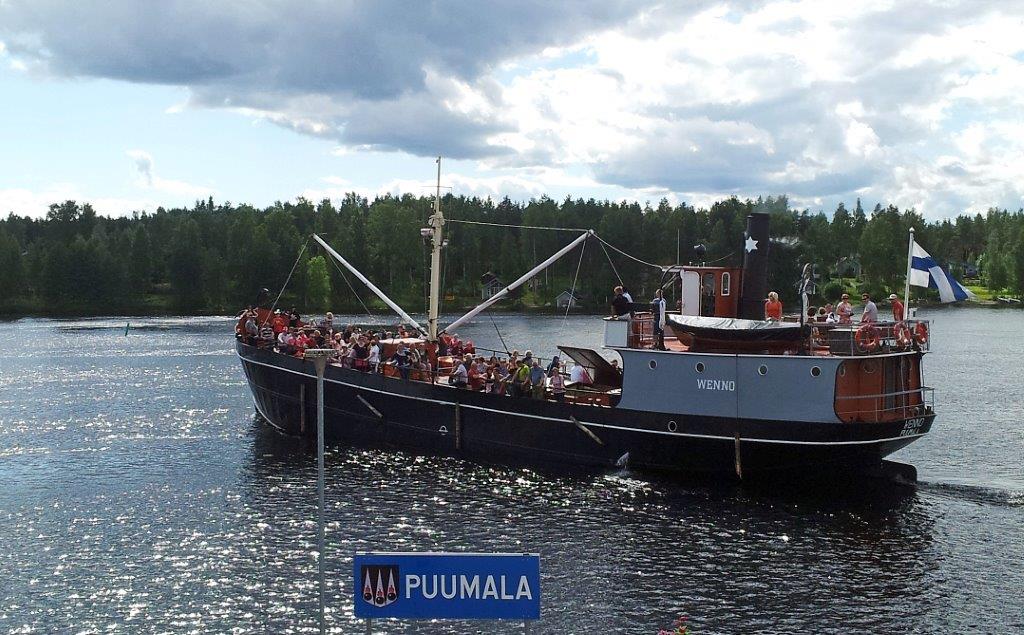Story
In 1907, the Miettula sawmill in Puumala’s Sahanlahti built an iron tar steam or “kuram mill” at the Savonlinna machine shop, which was named Wetehinen in baptism. Wetehinen transported sawn timber from the sawmill to the outer port of Vyborg in Ural as long as the sawmill was in operation. (K2011) Wetehinen was a so-called “full-load” steamer, ie it was dimensioned according to the closure chambers of the Saimaa canal and shaped so that it could hold as much cargo as possible. It could hold about 650 stack cubic meters, or moth logs. The steam boiler and machine were installed at the stern of the ship, where they took up as little space as possible from the cargo. The living quarters were also at the stern of the ship.
After the Miettula sawmill ceased operations in the 1920s, Wetehinen first passed to the Kosonen brothers and then to engineer Juho Vihtori Salo, working in various search cargo traffic. The ship was bought from Salo by Enso Gutzeit Oy in 1934. According to Gutzeit’s ship naming policy, its tar vapors and kuram mills were given five-letter crew names ending in the letter o. Wetehinen was named Wenno. That name is not a very common man’s name, but the Gutzeit company had a tradition of it: the company had had a wooden steamer named after it in 1920-33. In Gutzeit’s service, Wenno transported various types of cargo, such as logs to the company’s Tainionkoski factories. The Tainionkoski Sulphite Plant needed a large amount of fuel, and in 1955, for example, at least seven of the company’s tar vapors performed the same task: in addition to Wenno, Romeo, Heino, Teuvo, Paavo, Mikko, Tauno and Tarmo.
In 1960, Wenno got a “new” boiler with its own history. It was originally made for the cargo ship “Romeo,” but was unloaded from it in 1936 due to the corrosion of the stomach. Romeo then stood until 1939 until he got a new boiler. Romeo’s old boiler was instead refurbished and a sparrow “Wanda” was installed, which was then turned into a tug “Einari”. In 1960, Einari had remained standing, and when Wenno’s old boiler was found to be in poor condition, Einari’s boiler was moved to Wenno.
The variation in the daily transport of timber was brought about by rescue missions. Enso Gutzeit Oy had both the know-how and the equipment for lifting ships, and it also lifted the ships of other companies. Usually this was done by driving a barge or steamer sunk on both sides of the anchor, after which steel beams were installed between them to which the zinc was attached with lifting screws. The divers then went to attach the zinc to the sunken ship. The fleet also included one of the company’s large tugs with an efficient rescue pump. Its task was to empty the surface vessel and tow it to its destination.
However, Wenno’s main task was to transport logs and pulpwood, and it did so until 1964, when it was made to stand. At the turn of the 1970s, Gutzeit began selling his old steamships. It offered the badly dilapidated Wenno to the municipality of Puumala, because it was an old ship from Puumala. The current captain of the ship, Pentti Martikainen, recalls those times as follows: “Was it Murillo who towed the stripped-down Wenno to Puumala, where there was a discussion about whether to immerse it immediately or let the current go forward”. The future of the ship was a question mark, for example a café ship was planned. In the end, however, it was decided to rehabilitate it into traffic. The Puumalan Veneseura ry was established to host the vessel, and since then it has been responsible for the condition and maintenance of the ship, mainly as support work. The actual owner is the municipality of Puumala, which is responsible for insurance and docking, the boat club for the rest. Wenno has been inspected as a merchant ship for 99 people, and it makes various charter cruises from Puumala. It is currently the last representative of its steam-hulled steel hull type.
Technical information
- Length: 30.80m
- Width: 6.70m
- Depth: 2.60m
- Building year: 1907
- Building place: Savonlinna
- Shipyard: Savonlinnan Konepaja Oy
- Hull material: steel
- Engine: Compound, 96 IHV
- Fuel: wood
- Home port: Puumala




